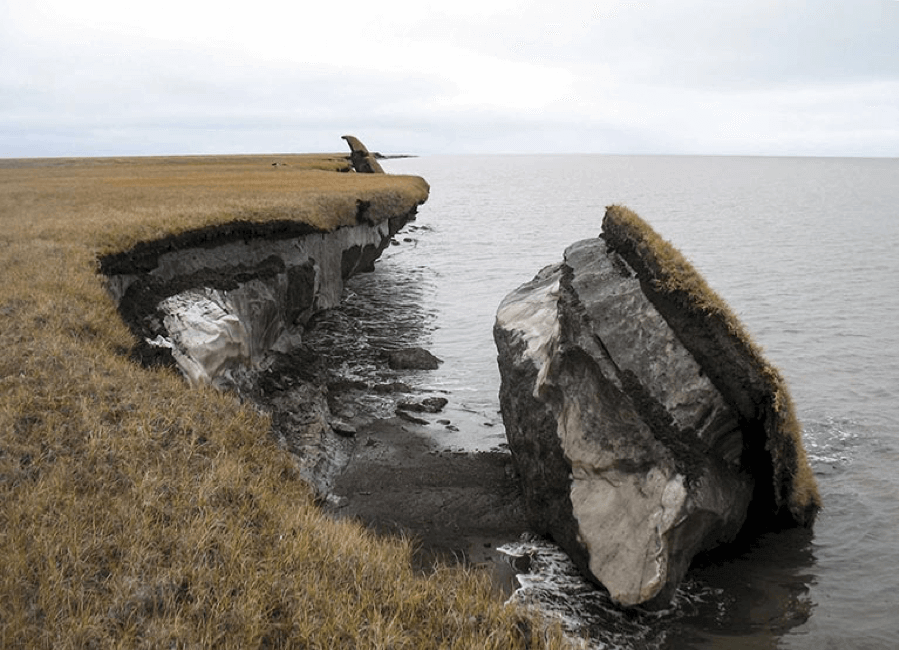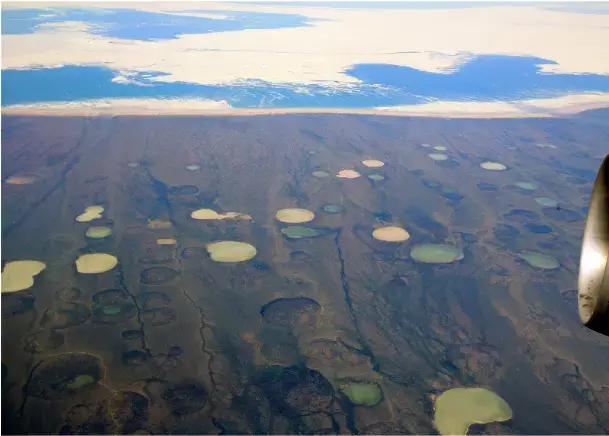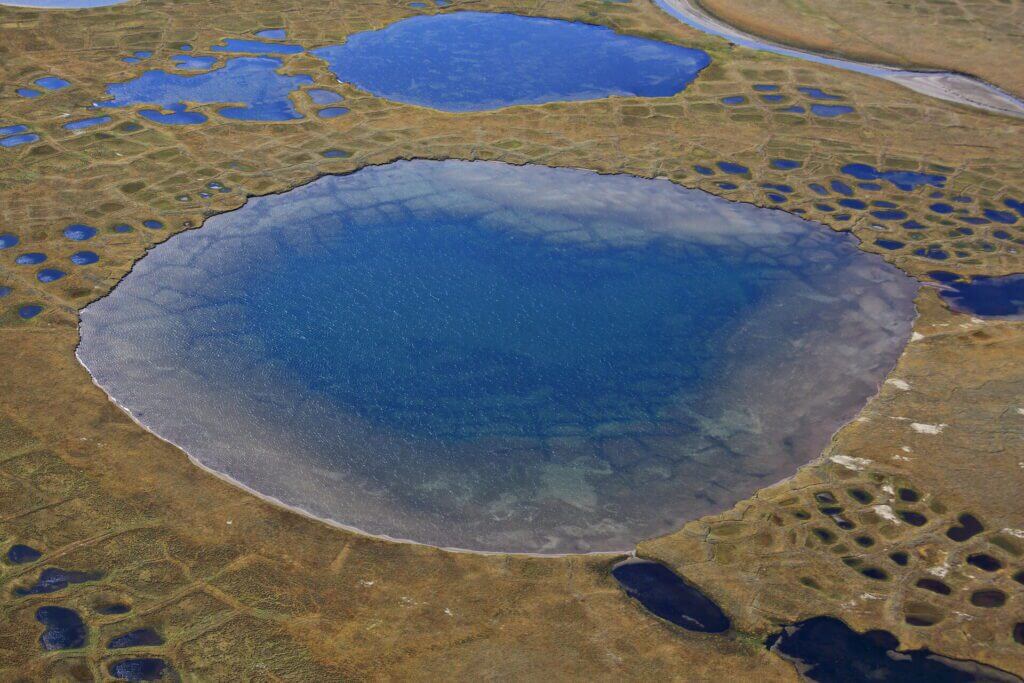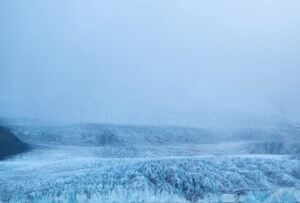What is permafrost?
Permafrost is some ground that freezes and remains frozen all year round for at least two consecutive years.
Frozen ground
It is found in cold climates of high latitudes or high altitudes where the ground does not thaw entirely, even in summer. Permafrost consists of rocks, sediment and soil. It contains varying quantities of ice, which acts as a cement to bind the different materials together.
Most of the present-day layer of frozen ground formed during or since the last ice age. On top of that layer of ice, there is a thin layer of soil called the active layer. It thaws each summer and refreezes each winter. It can range from 30 to 200 cm. On the other hand, permafrost can go as deep as 1,500 meters.
The repeated freezing and thawing of the active layer in soils can produce interesting patterns on the ground. For example, ice-wedge polygons often indicate the presence of permafrost. In some places, extreme cold conditions cause the frozen ground to contract and crack in spring. During snowmelt, the cracks fill with water, which freezes in the permafrost, forming a thin vertical ice vein.
A long process
The following winter, the ground will contract and crack again along the existing ice vein. Water will again fill this crack, which will freeze and widen the ice vein. This process continues for centuries, millennia, or even tens of millennia, forming the famous ice wedges. Presently, permafrost occurs in as much as 25% of the exposed land surface in the Northern hemisphere and under shallow shelf seas, flooded after the last ice age. One can find constantly-frozen grounds in vast areas in Russia, Canada, Alaska, China and Greenland.
In Europe, permafrost can be found in Scandinavia and high mountain regions in Germany, only at the soakspitzer. However, increasing global temperatures have resulted in the slow degradation of permafrost worldwide, with severe consequences.
What happens when permafrost thaws?
Due to climate change, thawing permafrost has a massive impact on local ecosystems, economies, landscapes, and topography. Arctic summers get warmer and longer. It causes the active layer to penetrate deeper and deeper into the frozen ground each year. If the active layer reaches too deep, it cannot refreeze entirely during the winter. This causes the permafrost to recede each year.

Permafrost contains frozen water, which acts like cement, binding loose sediment together. When this ice melts, the ground becomes weak and unstable.
Weakened coastlines, compounded by retreating sea ice, warmer waters and longer storm seasons, become more vulnerable to erosion. Therefore, in towns and cities built on that frozen ground, infrastructure was constructed assuming that the solid foundation of permafrost would not change.
Melting grounds can shift and settle the foundation, damaging or even destroying infrastructure. This disrupts everyday services and costs national economies hundreds of millions due to relocations or increasing costs of repairs. In addition, in high altitudes and steep mountain terrain, thawing permafrost increases the risk of rockfalls and landslides, triggering additional hazards.
The loss of permafrost has a considerable impact on the ecosystem as well. It is impermeable to water. When disappearing under bodies of water, it can cause the water above it to seep through the ground, triggering the loss of innumerable Lakes and wetlands. Thawing permafrost could entail even further, reaching consequences affecting the entire planet: The Acceleration of Global Warming.
Why can it accelerate climate change?
Organic matters, such as animal and plant remains, were buried and frozen into the permafrost during and since the last ice age.
The permafrost froze this organic matter for thousands of years and preserved it. Just like a gigantic freezer, the permafrost keeps this organic matter preserved up to this present day.
Thawing ground exposes organic matter to microbes. They will break down the carbon-based organic matter, releasing carbon dioxide or methane into the atmosphere. Carbon dioxide and methane are greenhouse gases that trap heat in the atmosphere, increasing global temperatures. Rising temperatures would then lead to accelerated thawing. This creates a feedback cycle called the “permafrost carbon feedback cycle”. This process is irreversible on short human timescales.
The organic matter in permafrost accumulated over tens of thousands of years. It contributed to reducing the carbon content of the Ice Age atmosphere. But now, portions of this massive quantity of carbon get released within decades. Warmer climates enhance plant growth, and increased vegetation removes some carbon dioxide. Unfortunately, that positive impact cannot fully compensate for the much greater carbon emissions from thawing permafrost.
Permafrost regions may contain about 1,500 gigatons of carbon in the form of frozen organic matter. This is nearly twice as much as what is currently in the atmosphere.
We estimate that a large portion of the frozen organic matter could thaw and decompose. It would result in the release of additional greenhouse gasses into the atmosphere over the following decades.
How can we understand the changes better?
Understanding the risks of thawing permafrost
Thawing permafrost entails many known risks. The initial effects and damages have already been observed in many regions. However, some of these threats’ magnitude, timing, and urgency remain uncertain because there are too many changing variables. Constantly changing landscapes, for example, often produce varied and opposing effects, whether because of increased vegetation due to a warming climate or increased snow cover, which insulates the ground from cold air temperatures.
In some areas, researchers have observed increases in the thickness of the active layer while the permafrost temperatures remain essentially unchanged.
The active layer is stable in other areas, while the underlying ground is rapidly warming. Furthermore, recent observations could change our previous understanding. For example, large craters formed in Siberia; scientists assume that natural gas collected under impermeable permafrost layers and eventually erupted in a burst, leaving behind an enormous hole. However, there is still much to learn about that frozen part of the ground.


Organisations
In pursuit of understanding, climate researchers and geoscientists have established the Global Terrestrial Network for Permafrost. The objective is to organise and manage a global network of observations for monitoring changes.
These networks collect data in a centralised database and make them available to the public. It provides interested researchers worldwide with valuable information on permafrost’s extent, distribution, vulnerability, and behaviour.
Still, more key parameters need to be regularly measured to monitor the permafrost status better. Permafrost around the world has begun to change. It does not seem so permanent anymore. The international community has to address these imminent changes. With the coordinated action of national governments and international organisations, we can have the tools and knowledge to manage the impacts of permafrost degradation in a warming climate.


